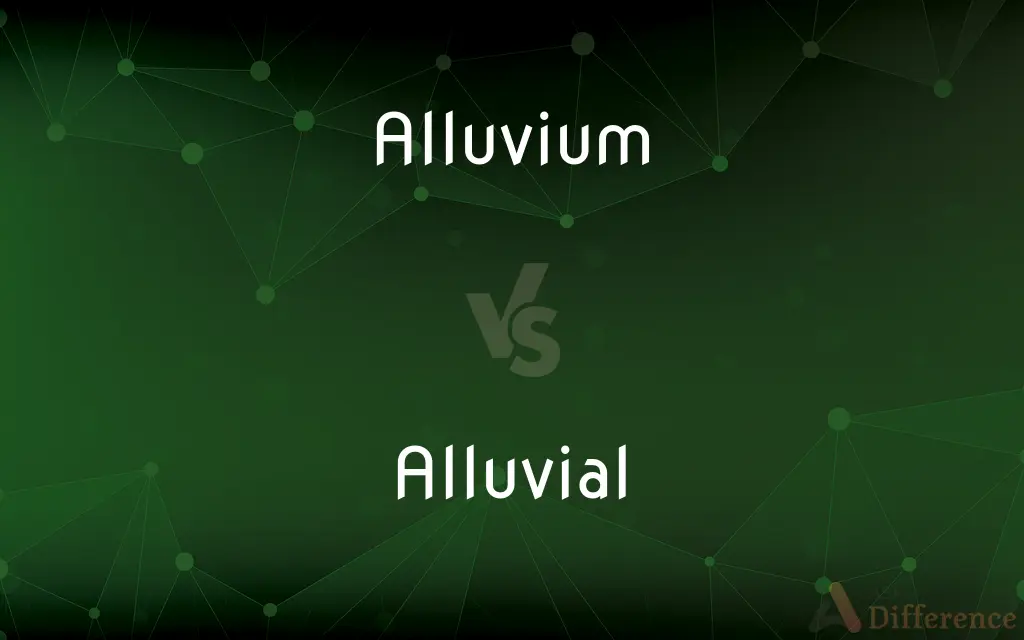Alluvium vs. Alluvial — What's the Difference?
By Maham Liaqat & Urooj Arif — Updated on March 17, 2024
Alluvium refers to sediment deposited by rivers, while alluvial describes soils or features formed by such sediments.

Difference Between Alluvium and Alluvial
Table of Contents
ADVERTISEMENT
Key Differences
Alluvium encompasses the particles and sediments carried and eventually deposited by flowing water, particularly rivers. These deposits can range from clays to sands to gravels, forming layers in various environments. On the other hand, the term alluvial is used to describe materials, soils, or formations that have been created from alluvium. It's an adjective that characterizes the nature or origin of such deposits.
While alluvium directly pertains to the material itself—sands, silts, clays, and gravels—deposited over time, alluvial refers more broadly to the context in which these materials are found. For instance, alluvial plains or alluvial fans are geographical features shaped by the deposition of alluvium. This distinction emphasizes the difference between the physical materials (alluvium) and their resultant formations or characteristics (alluvial).
The study of alluvium can reveal much about past environmental conditions, such as the flow direction of ancient rivers or the climate at the time of deposition. Alluvial, in its usage, often relates to the suitability of land for agriculture, as alluvial soils are typically fertile and rich in nutrients, thanks to the mix of minerals from different sources.
Alluvium deposits are critical for understanding geological processes, including erosion and sedimentation. In contrast, the concept of alluvial helps in assessing the practical implications of these deposits, such as their impact on agriculture, construction, and habitat creation. For example, alluvial soils are sought after for farming due to their high fertility.
Geologists and geomorphologists might focus on studying alluvium to understand sedimentary processes and history. Meanwhile, agriculturists and environmentalists are more concerned with alluvial contexts, evaluating soil quality, fertility, and the potential for sustainable land use. This delineation underscores the material's scientific significance versus its practical or ecological applications.
ADVERTISEMENT
Comparison Chart
Definition
Sediment deposited by rivers.
Pertaining to or composed of alluvium.
Nature
Material (clays, sands, gravels).
Descriptive of the nature or origin.
Study Focus
Geological processes, sedimentation.
Soil quality, agriculture, construction.
Example Features
Deposits in river beds, floodplains.
Alluvial plains, fans, soils.
Relevance
Understanding past climates, geography.
Agriculture, land use, ecological value.
Compare with Definitions
Alluvium
Sediment deposited by rivers or floodwaters.
The geologist studied the alluvium to trace the river's ancient path.
Alluvial
Relating to soil made up of river-deposited sediments.
The alluvial soil in the delta was extremely fertile.
Alluvium
Deposits formed by sedimentation.
The valley was filled with alluvium after centuries of flooding.
Alluvial
Concerning the process of deposition by water.
Alluvial processes shaped the landscape over millennia.
Alluvium
A mix of gravel, sand, silt, and clay.
Alluvium layers revealed different periods of deposition.
Alluvial
Pertaining to deposits from freshwater sources.
Alluvial deposits near the stream were ideal for the study.
Alluvium
Material making up riverbeds and deltas.
Excavating the alluvium, they found artifacts from early settlements.
Alluvial
Characterizing features formed by sedimentation.
The alluvial fan spread widely at the mountain's base.
Alluvium
Geological layers indicating past environments.
The alluvium's composition suggested a once warmer climate.
Alluvial
Describing areas affected by alluvium.
They farmed on the alluvial plain, where the soil was rich.
Alluvium
Alluvium (from the Latin alluvius, from alluere, "to wash against") is loose clay, silt, sand, or gravel that has been deposited by running water in a stream bed, on a floodplain, in an alluvial fan, or in similar settings. Alluvium is also sometimes called alluvial deposit.
Alluvial
Relating to or derived from alluvium
Rich alluvial soils
Alluvium
Sediment deposited by flowing water, as in a riverbed, flood plain, or delta. Also called alluvion.
Alluvial
Of, relating to, or found in alluvium
Alluvial soil.
Alluvial gold.
Alluvium
Soil, clay, silt or gravel deposited by flowing water, as it slows, in a river bed, delta, estuary or flood plain
Alluvial
Pertaining to the soil deposited by a stream.
Alluvium
Deposits of earth, sand, gravel, and other transported matter, made by rivers, floods, or other causes, upon land not permanently submerged beneath the waters of lakes or seas.
Alluvial
(countable) A deposition of sediment over a long period of time by a river; an alluvial layer.
Alluvium
Clay or silt or gravel carried by rushing streams and deposited where the stream slows down
Alluvial
Alluvial soil; specifically, in Australia, gold-bearing alluvial soil.
Alluvial
Alluvial soil; specif., in Australia, gold-bearing alluvial soil.
Alluvial
Pertaining to, contained in, or composed of, alluvium; relating to the deposits made by flowing water; washed away from one place and deposited in another; as, alluvial soil, mud, accumulations, deposits.
Alluvial
Of or relating to alluvium
Common Curiosities
Can alluvium indicate historical climates?
Yes, the composition of alluvium can offer clues about past climates and environmental conditions.
What distinguishes alluvial plains from other plains?
Alluvial plains are specifically formed from the deposition of alluvium by rivers, making them rich in nutrients.
What is alluvium made of?
Alluvium is made of varied sediments like gravel, sand, silt, and clay deposited by water.
Why are alluvial soils fertile?
Alluvial soils are fertile due to the mix of minerals and organic matter from different sources.
How does alluvium affect landscapes?
Alluvium shapes landscapes through the creation of features like river deltas, plains, and fans.
Can the study of alluvium help in archaeology?
Yes, examining alluvium layers can help archaeologists locate ancient settlements and understand past human activity.
Is alluvium found only in rivers?
While commonly associated with rivers, alluvium can also be deposited by other water flows, like streams and floods.
Why are alluvial deposits important for construction?
Their characteristics, such as particle size and composition, can influence the stability and suitability of land for construction.
Do all alluvial soils have the same characteristics?
While generally fertile, the specific characteristics of alluvial soils can vary based on their composition and the environment of deposition.
How are alluvial deposits identified?
They are identified based on their composition, texture, and the context of their deposition.
Are there environmental concerns associated with alluvium?
Environmental concerns can include erosion, sedimentation affecting waterways, and impacts on floodplains.
What are alluvial fans?
Alluvial fans are triangular-shaped deposits formed where a fast-flowing river flattens, slows, and spreads typically at the exit of a canyon onto a flatter plain.
How does human activity affect alluvial deposits?
Activities like construction, agriculture, and damming can alter the natural deposition and erosion processes, impacting ecosystems and land use.
How do alluvium and alluvial relate to agriculture?
Alluvial soils, derived from alluvium, are highly prized in agriculture for their fertility and water-retaining capacity.
What role does alluvium play in river ecosystems?
Alluvium supports river ecosystems by providing habitats and influencing water flow and quality.
Share Your Discovery

Previous Comparison
Vapour vs. Vapor
Next Comparison
Analphabet vs. IlliterateAuthor Spotlight
Written by
Maham LiaqatCo-written by
Urooj ArifUrooj is a skilled content writer at Ask Difference, known for her exceptional ability to simplify complex topics into engaging and informative content. With a passion for research and a flair for clear, concise writing, she consistently delivers articles that resonate with our diverse audience.
















































